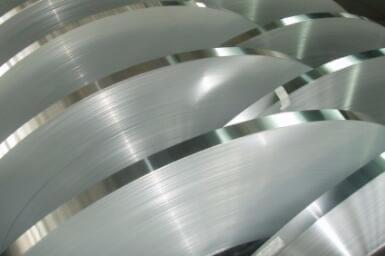- 0531-87887788
来源:http://www.jndclyyxgs.com/ 发布时间:2021-11-27
铝板在我们的生活中被广泛使用。 可能大家的门窗都是用铝板加工而成的。 铝板是如何生产的? 接下来,正隆铝业祥祥为您介绍铝板的生产工艺。
Aluminum plates are widely used in our life. Maybe everyone’s doors and windows are made of aluminum. How are aluminum sheets produced? Next, Zhenglong Aluminum Xiangxiang introduced to you the production process of aluminum plate.
铝及铝合金板带材的加工状态包括热轧状态、退火状态、各种牌号的软状态和各种热处理状态。 铝合金板的生产方法分为块法和带法两种。 分块法是将热轧薄板切成几块,然后穿过一块钢板冷轧成成品。 带钢规则是将板坯轧制到一定的厚度和长度,然后卷取轧边,达到成品的厚度后,将板材切割成单块铝材。 该方法生产效率高,产品质量好。
The processing state of aluminum and aluminum alloy plate and strip includes hot rolling state, annealing state, soft state of various brands and various heat treatment state. The production method of aluminum alloy plate can be divided into block method and strip method. The method is to cut a hot-rolled sheet into several pieces, and then pass through a sheet of steel and cold-rolled into a finished product. Strip rules are rolled to a certain thickness and length of the slab, and then rolled edge coiling, to reach the thickness of the finished product, the plate is cut into a single piece of aluminum. The method has the advantages of high production efficiency and good product quality.

轧前准备主要包括钢锭质量检验、浸渍、锯切、轧制、镀铝、加热等。铝板生产厂家使用优质钢锭是保证成品质量的前提。 现代铝合金带材生产中使用的钢锭大多采用半连续钢锭法生产。 锭具有较大的尺寸和细小的枝晶。在半连续铸造中,冷却速度快,固相扩散过程困难,铸锭的化学成分和组织容易形成不均匀,如结晶偏析,使塑性降低。
Pre-rolling preparation mainly includes ingot quality inspection, impregnation, Sawing, rolling, aluminizing, heating and so on. The use of high-quality ingots by aluminum plate manufacturers is a prerequisite for ensuring the quality of finished products. Most of the ingots used in the production of modern aluminum alloy strip are produced by semi-continuous ingot method. The INGOT has large size and fine dendrite. In semi-continuous Casting, the cooling rate is fast, the solid diffusion process is difficult, and the chemical composition and microstructure of the ingot are easy to form inhomogeneity, such as crystallization segregation, so that the plasticity is reduced.
因此,一些铝合金,特别是硬质铝合金锭,需要进行均质化(见有色合金锭的均质化),以消除或减少成分和组织的不均匀,消除铸造应力。 铝合金的均质化温度应低于合金的低熔点共晶温度10-15℃,保温时间为12-24小时,基本消除了成分和组织的不均匀性。 对于硬质铝合金,钢锭均质温度为480~495℃,保温时间为12~15h。 Al-Zn-Mg-Cu 合金在 450-465°C 下保持 24 小时。
Therefore, some aluminum alloys, especially hard aluminum alloy ingots, need to be homogenized (see non-ferrous alloy ingots homogenization) in order to eliminate or reduce the inhomogeneity of composition and structure, to eliminate casting stress. The homogenization temperature of aluminum alloy should be 10-15 °c lower than the eutectic temperature of alloy with low melting point, and the holding time should be 12-24 hours. For hard aluminum alloy, the INGOT homogenization temperature is 480 ~ 495 °C and the holding time is 12 ~ 15h. Al-Zn-Mg-Cu alloy was maintained at 450-465 °C for 24 hours.
当钢锭表面有偏析浮渣、夹渣、疤痕、裂纹等缺陷时,应进行表面磨削(见有色金属合金钢锭表面磨削),铝板生产厂家保证成品表面质量的因素。 切割量取决于缺陷的深度,通常为 4 到 10 毫米。
When the INGOT surface has defects such as segregation scum, slag inclusion, scar and crack, surface grinding should be carried out (see Non-ferrous metal alloy ingot surface grinding) , which is an important factor to ensure the surface quality of the finished product. The amount of cut depends on the depth of the defect, usually 4 to 10 mm.